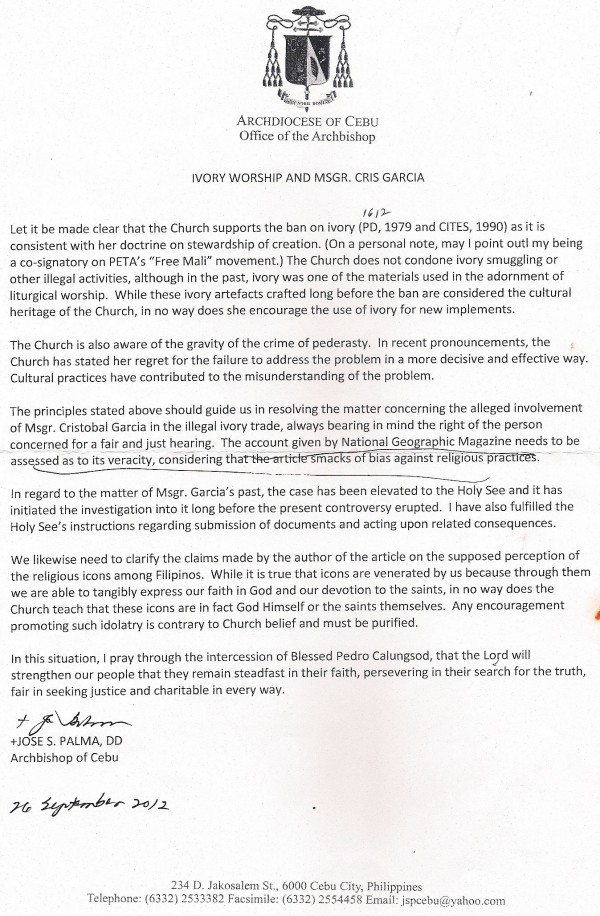|
| “blood Ivory” in the Philippines
By Bryan Christy
National Geographic
September 27, 2012
http://newswatch.nationalgeographic.com/2012/09/26/blood-ivory-in-the-philippines/
“Blood Ivory: Ivory Worship” is generating keen interest in the Philippines. The country’s ivory trade has been the cover story of the Philippine newspapers this week and is receiving similar attention across the country, especially on the island of Cebu.
Earlier today Jose S. Palma, Archbishop of Cebu, held a press conference, “Ivory Worship and Msgr. Cris Garcia” (see below), in which he reportedly announced that ivory collector Monsignor Garcia had been suspended and stripped of his position in the archdiocese of Cebu on orders of the Vatican. Palma emphasized that this move was not the result of my investigation, which features Garcia, but rather is the result of Garcia’s sexual abuse of minor boys while serving in Los Angeles, California in the 1980s. The case was exposed by Brooks Egerton of the Dallas Morning News as part of that newspaper’s 2005 series, “Runaway Priests: Hiding in Plain Sight.” My story cited the Dallas Morning News story and reiterated Garcia’s past.
“Let it be made clear that the Church supports the ban on ivory,” Palma says in his written statement for the press today. He then opened the door to an important possibility for elephants and the Africans who risk their lives to protect them: “…in the past ivory was one of the materials used in the adornment of liturgical worship…in no way does [the Church] encourage the use of ivory for new implements.”
Will the Church go a step further and disavow the active carving of ivory for religious purposes and the selling and trading of new images by devotees? Archbishop Emeritus Oscar Cruz does exactly that in an interview today with the Philippine Daily Inquirer. Cruz calls for a stop to the use of elephant tusks for religious images “because it is contrary to the signs of the times.” There are better materials to use, he says.
This is the uplifting possible outcome of uncovering the role of religion in fueling the ivory trade in the Philippines, Thailand, China, and elsewhere: It is a practice contrary to the times, and it is contrary to basic religious principles, including respect for life.
It is worth emphasizing that the “Blood Ivory” story is not intended to paint Cebu as a place where illegal ivory trade is “overflowing” but rather as a place where devotion to the Santo Nino is deep, and where many people maintain religious images, and some have them in the form of ivory. What is legal or illegal depends on the circumstances.
Regrettably Archbishop Palma also says my story “smacks of bias against religious practices.” It would be more heartening if he had noted the work the story has done to expose exploitation of children, animals, and civil society in the Philippines and Africa.
The Department of Environment and Natural Resources (DENR) and the National Bureau of Investigation (NBI) have launched investigations into the Philippines’ ivory trade.
Archbishop Palma’s Statement
 |
|
In a statement released to the media and posted on the church-run Veritas Radio website on Wednesday, the President of the Catholic Bishops’ Conference of the Philippines (CBCP), Jose Palma, Archbishop of Cebu, said: “Let it be made clear that the Church supports the ban on ivory as it is consistent with her doctrine on stewardship of creation … The Church does not condone ivory smuggling or other illegal activities, although in the past, ivory was one of the materials used in the adornment of liturgical worship. While these ivory artefacts created long before the ban are considered the cultural heritage of the Church, in no way does she encourage the use of ivory for new implements.”
|
